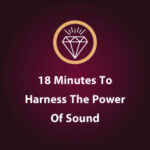So apparently, a low frequency sound is responsible for the creation of our universe. That’s the low tone of a plasma cloud as it creates order out of chaos. And really, all sound is just a vibration. Like our existence is filled with “energy”, it’s also filled with “vibration”. And our biological, carbon-based and limited meat suits, translate this as SOUND.
It turns out, our ears enjoy three times more neural connections to the brain than our eyes do. That means we can hear a much broader spectrum of sound, than we can see a spectrum of colors. And as I’ve already mentioned previously, sound is one of the quickest ways to our emotions – and our brains. (The other sense that’s like this, is the sense of smell.)
I’ve also spoken previously about how music can influence our moods. I have an upcoming interview with a fellow who uses HipHop music to help his clients embrace a more positive outlook on life. People create “playlists” to keep them energized when they’re exercising or to allow them to wallow in sadness. Music can change the way we look at the scenes in a movie, making them more impactful. (Just try watching a movie – ANY movie – without the sound. It loses a lot of its meaning and your engagement goes WAY down.)
We create lots of pieces of media that include sound as an element. But what about actual, physical, spaces? This is where architecture and sound vibrations, meet. There are actually buildings crafted specifically to allow us to hear tones that feel uplifting or inspiring to us. Shea Trahan (https://www.sheatrahan.com/), an architect intrigued by how sound works through his chosen instrument of creation, studied this in detail. He talks about Resonance – sound as “sympathetic vibration” – and relates that to buildings that seem to exist to amplify this. Then he adds information about Reverberation – how long a sound lingers once the source sound has stopped. The combination in a building, makes it the idea place for a concert.
His TEDx talk is fascinating. I’ll link to it hear so you can have a look (and listen) for yourself. And while he admits that the applications of this kind of study have a lot to do with entertainment, he also acknowledges that it could be used for health care.
Sonic therapy is useful for the treatment of PTSD, depression, Parkinson’s and Alzheimer’s disease. Imagine how useful a space could be if it had built in healing resonances and reverberations. The applications are endless. And I’ll talk more about sound for health care in future blogs. For now, have a look at his TEDx presentation, and see what you think:
Would you consider reviewing the Audio Branding Podcast? If so, here’s the Apple Podcast link: https://podcasts.apple.com/podcast/audio-branding/id1489042453 And if you like what you hear (and read!) – please do share it with anyone you think might be interested. Thanks so much!

